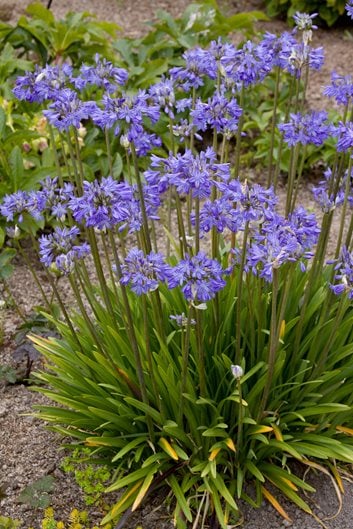Agapanthus Growing Problems: Dirt, Sunlight, and Watering
Agapanthus Growing Problems: Dirt, Sunlight, and Watering
Blog Article
Understanding the Art of Agapanthus Treatment: Important Steps for Healthy Development and Lively Blossoms
In the world of horticulture, the cultivation of agapanthus stands as a fulfilling venture for those who look for to nurture these sophisticated blooming plants. With their striking flowers and graceful vegetation, agapanthus has caught the interest of garden enthusiasts worldwide. Nevertheless, accomplishing optimum growth and vivid blossoms needs a nuanced approach that encompasses numerous vital actions. From choosing the appropriate range to grasping trimming techniques, the trip towards growing thriving agapanthus plants is diverse and holds the crucial to opening the full capacity of these organic treasures.

Picking the Right Agapanthus Range

When picking the ideal Agapanthus selection for your garden, consider elements such as environment viability, flower shade, and development practice. Additionally, take into consideration the climate in your area to make sure the Agapanthus range you pick can prosper in your specific problems. Understanding the growth behavior of different Agapanthus ranges is critical for appropriate placement within your yard.
Perfect Planting Conditions
Considering the ideal environmental requirements is essential for successful Agapanthus growing. Agapanthus plants are delicate to cold temperature levels and must be safeguarded from frost throughout wintertime months.
To make sure healthy growth and lively flowers, plant Agapanthus bulbs at a depth of about 2-4 inches and space them 8-12 inches apart. Including raw material, such as compost, to the dirt can enhance drain and fertility, promoting robust origin advancement. Mulching around the base of the plants aids maintain moisture and subdues weed development. Routine watering is important, specifically during the growing period, to maintain the dirt consistently wet yet not soaked.
Watering and Feeding Tips
Preserving appropriate dampness degrees and offering important nutrients are key aspects in the treatment regimen for Agapanthus plants. When it comes to sprinkling Agapanthus, it is crucial to strike an equilibrium. These plants prefer consistently damp soil but are susceptible to root rot if overwatered.
Feeding Agapanthus is crucial for promoting healthy and balanced growth and prolific blooms. Use a balanced plant food, such as a 10-10-10 formula, in the early spring as brand-new growth emerges. By following these watering and feeding suggestions, you can ensure your Agapanthus plants flourish and create vivid, resilient flowers.
Pruning Techniques for Agapanthus
Trimming Agapanthus plants at the appropriate times and with proper strategies is vital for maintaining their wellness and promoting optimum growth and blooming. The excellent time to trim Agapanthus is in late winter months or early springtime before new growth arises.
Deadheading spent flowers can additionally redirect the plant's energy right into generating even more blooms rather than establishing seeds. If you desire to collect seeds for breeding, leave some flowers to dry and mature on the plant.
Keep in mind to utilize tidy, sharp devices to make specific cuts and lower the danger of presenting conditions. Agapanthus. Normal pruning will assist keep your Agapanthus looking healthy and cool while ensuring an abundant display of lovely flowers
Managing Usual Bugs and Conditions
After ensuring proper pruning strategies for Agapanthus, it is important to attend to typical pests and illness that can impact the health and wellness and vitality of these plants. Agapanthus plants are usually browse around this site hardy yet can still drop target to particular issues. One usual bug that influences Agapanthus is the Agapanthus gall midge. This little, orange fly lays its eggs in the foliage, leading to altered growth and blossom buds that fail to open. To fight this parasite, trim and ruin any type of damaged plant parts and think about using insecticidal soap.
Furthermore, Agapanthus plants can suffer from origin rot if they are grown in improperly draining pipes soil. By being alert and taking prompt action versus pests and diseases, you can aid your Agapanthus plants grow and create vivid flowers. Agapanthus.

Final Thought
To conclude, mastering the art of agapanthus care includes choosing the ideal variety, providing suitable growing problems, proper watering and fertilizing, proper trimming techniques, and addressing common pests and illness. By following these necessary actions, you can make sure healthy growth and vivid blooms for your agapanthus plants. Remember to regularly keep track of and maintain your plants to advertise their total wellness and long life.
To make certain healthy development and dynamic blooms, plant Agapanthus light bulbs at a site web depth of regarding 2-4 inches and space them 8-12 inches apart. By following these watering and fertilizing tips, you can ensure your Agapanthus plants prosper and generate vibrant, lasting blooms.
One common parasite that affects Agapanthus is the Agapanthus gall midge. Furthermore, Agapanthus plants can experience from root rot if they are planted in poorly draining pipes soil. By discover this adhering to these necessary actions, you can make certain healthy development and vivid flowers for your agapanthus plants.
Report this page